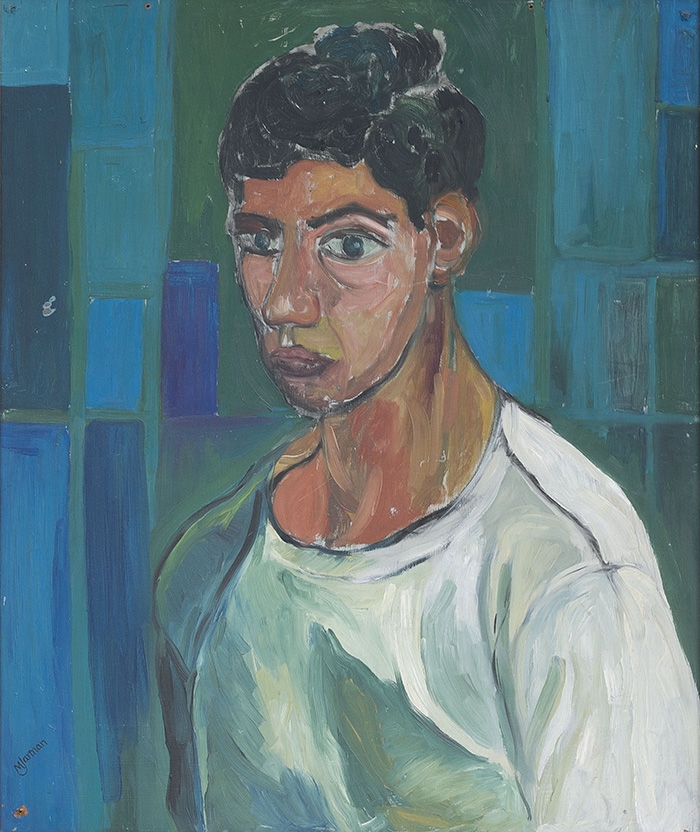The visitor to this revelatory survey is greeted by the checked gaze of the sixteen-year-old Derek Jarman, almond-eyed and curly haired, in a 1959 half-length self-portrait in oil. The young artist looks over his left shoulder, chest angled towards the threshold leading into the next room in the exhibition. Through it streams a blue light that picks out the cobalt panels in the painting’s Cezanne-ish patchwork background, accompanied by a voice reciting the litany of treatments associated with late-stage AIDS. Pairing the juvenile painting with Jarman’s elegiac monochrome film Blue (1993) establishes the points between which this retrospective oscillates: figuration and abstraction, stillness and movement, materialism and mysticism, the body and the soul. The scratches that fleck the film’s otherwise immaculate frames of International Klein Blue, meanwhile, introduce a body of work that seeks transcendence in the flawed physical world.
These career bookends also establish a narrative arc – from the performance of artistic identity to naked self-expression – that an otherwise chronological presentation sometimes supports and other times complicates. Charting his education at London’s Slade School of Art in the mid-1960s, a room of early experiments in modernist painting – from Fauvism to Vorticism, Art Informel to Pittura Metafisica – suggests an artist trying on styles to fit, although the canvases are elevated above pastiche by the student’s facility and the emergence of motifs that will recur throughout his career. These magpie early canvases do not disguise the influence of artists as varied as Wyndham Lewis and William Crozier, while also suggesting an artist seeking to distinguish himself. Indeed, Jarman never abandons the impulse to ventriloquise – as late as 1991, he is inspired by a Frank Auerbach exhibition to knock out some spiky impasto landscapes – or the fondness for sgraffiti and pentimenti that suggest hidden and partially revealed meanings.
A series of paintings from the late 1960s mark Jarman’s achievement of a style appropriate to both his own preoccupations and the times through which he was living. That the cartographical lines and printed matter of Landscape with a Blue Pool (1967) recall the architectural collages of Milan’s then-recently founded Superstudio feels more like synchronicity than cross-pollination: different artists catching the same wind. Indeed, so compelling are previously unexhibited works including Landscape with Crow (1967) – loaded with symbols and spells – that it’s hard to suppress a pang of regret that his imminent discovery of filmmaking, and his own restless curiosity, diverted Jarman from devoting more time to the possibilities opened up by these paintings.
The story told by the rest of the exhibition is more familiar, although the opening, with its focus on rarely seen paintings, illuminates the grammar underpinning Jarman’s work in the languages of theatre, literature, pop music, horticulture, film and activism (a legacy extended by his many mentees, from actor Tilda Swinton to filmmaker Isaac Julien and costumier Sandy Powell, whose creations for Jarman’s 1993 film Wittgenstein are displayed here). While the curating resists the temptation to refer everything back to Jarman’s celebrated feature films (a screening programme makes them available without attempting to shoehorn them into the exhibition’s narrative), it does help to situate them within his broader artistic development. A looping compilation of Super 8 shorts, for instance, reveals the increasing sophistication of his editing techniques as well as his evolution from Warholian flatness into a more expansive literary romanticism.
The impression that Jarman’s multifaceted practice is best understood collectively is reinforced by the intelligent, cross-referencing arrangement of sketches, photographs and films. The recurrence of esoteric and alchemical symbols including sphere, stone and pyramid in drawings, paintings, films and costumes illustrate how a single artistic project can be refracted through different media. The sheer volume of his production means that these forays into set design, poetry and music videos are inevitably teasing rather than satisfying, prompting the hope that offshoot exhibitions might pick up the thread.
The ‘protest’ of the exhibition’s title, most literally represented by film and photographic documentation of Jarman’s crusading work as an AIDS activist, is a principle underpinning his work rather than an end to which it is put or extracurricular activity. The provocatively priapic paintings exhibited at the height of Mary Whitehouse’s moral crusade during the early 1980s, for example, are a stark reminder that no work here is untouched by the experience of a politically active gay man living through Thatcherism and the crisis. But the more explicitly activist works should not be separated from gentler surprises, including an orgiastic and never before exhibited 1979 painting (Pleasures of Italy), which half-conceals a swirl of poetic fragments under a dirty white screen of paint. The work protests the suppression by a materialist and prescriptive society of the mystery and esotericism that are fundamental to Jarman’s version of beauty.
Yet even the foreknowledge of how this must end will not inoculate visitors from the devastating effects of the final rooms. First come a series of monumental canvases composed with the help of studio assistants (the ailing artist reduced to pulling his bare fingers through the acrylic to inscribe desperate five-furrowed tracks and circular swirls in their surfaces). Finally, a series of wall-hanging assemblages created in the seaside cottage to which the dying artist retreated, first exhibited in 1992, foreground the impedimenta of illness: pill boxes, vials, syringes and pumps. They attest to 35 years making art out of a radical life and agonised death.
Derek Jarman PROTEST! at IMMA, Dublin, 15 November – 23 February
From the March 2020 issue of ArtReview
